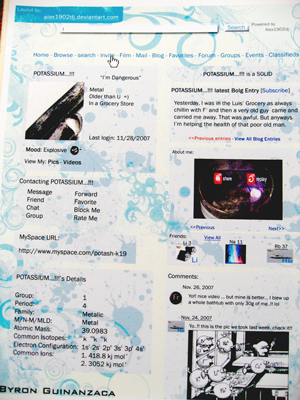
Subject:Chemistry, ESL, technology, and art
Grade Level: 10-12
Description: This unit helps students understand the specific properties of each of the chemical elements listed on the periodic table. They also learn about the arrangement of the elements on the periodic table and use this information to design a myspace page for a chemical element.
How it Works: My Chemical Spaces focuses on the periodic table of the elements. After learning about the design of the table and general properties of different groups of elements, the students design a Myspace page for an assigned chemical element. Using the Internet to gather specific information, students organize their research on their myspace page to include: biographical information and photos of their elements and, by comparing the properties, they select other elements to be “friends” of their elements. They are given a template to follow that resembles a myspace page with the information they are required to find. The students are also given creative freedom to include any other details they think is relevant.
After the completion of their myspace projects students gathered into groups that included similar elements to theirs and discussed the general properties of their elements. They made presentations to the class to describe their elements properties. Afterwards all the projects were placed together to create a large periodic table for display in the school.
Final Project/Product: The final project is the myspace page and the periodic table display for the hallway of the school.
Overall Value: My Chemical Spaces uses a popular website, myspace.com, to motivate students to learn about the periodic table. Not only does this project cover the chemistry curriculum, it allows students to be creative and artistic, and add humor to their work. It uses the Internet for research and involves writing, technology, and the arts to help learn science.
English Language Learners: Students organize information in English from the Internet to include in their myspace page. The project incorporates writing and stresses vocabulary. They use visuals to relay information on their myspace page. They also discuss and compare their projects to make a summary of properties.
Tips for the Teacher: Teachers should familiarize themselves with the types of information used on myspace to help design a template for your class. Examples of myspace pages should be printed for class use because some schools have blocked access to myspace.com on the Web. If a large number of students are not available, limit the myspace elements to the most common on the periodic table. It is not required to construct the page on a computer, so students do not feel pressured to use a medium they are not comfortable with.
|
| Students read, write, listen, and speak for information and understanding. |
| Grade: 9-12 Subject: English Language Arts |
| Students actively engage in the processes that constitute creation and performance in the arts and participate in various roles in the arts. |
| Grade: 9-12 Subject: Arts |
| Students access, generate, process, and transfer information using appropriate technologies. |
| Grade: 9-12 Subject: Science |
| Students understand the relationships and common themes that connect mathematics, science, and technology and apply the themes to these and other areas of learning. |
| Grade: 9-12 Subject: Science |
| Day 1: Introduction to the Periodic Table of Elements. |
| Objectives |
| Students will be able to compile a list of metal properties and nonmetal properties. |
| Students will be able to analyze data to describe how the periodic table is organized and present their findings to the class. |
| Students will be able to identify elements with similar properites. |
|
|
| Materials |
| Copper wire (1 per group) |
| Sulfur (small sample per group on an evaporating dish) |
| Transparency of the periodic table |
| Colored pencils |
| Keywords |
| Metal, nonmetal, malleable, ductile, luster, brittle, dull, conductor , metalloid, transition |
| Procedure 1 |
| The periodic table is organized by metals and nonmetals. |
| a. Give each group a piece of copper wire and some sulfur. Have them observe the two substances and develop a list of physical properties of each. Later, ask the students to present their findings. |
| b. Review the properties of a metal and a nonmetals stressing and defining the vocabulary above, and stressing opposites such as malleable/brittle, dull/ shiny luster, and metal/nonmetal. |
| c. Review the properties of metalloids and show the students where each group lies on the periodic table: metals on left, nonmetals on the right, and metalloids on the border of the two. |
| d. Give students colored pencils and have students color in their table. Instruct them to use one color for metals, one color for nonmetals, and one color for metalloids. They should create a key at the bottom to identify what each color represents. |
| |
| Procedure 2 |
| The periodic table is organized by groups and periods. |
| a. Place the transparency of the periodic table on the projector. |
| b. In their groups, have students observe how the elements are arranged on the table. |
| c. Review similarities of groups (same number of valence electrons) and of periods (same number of occupied energy levels). |
| d. Explain that elements in the same group have similar properties. |
| |
| Extension |
| Students can create a venn diagram showing the differences of metals properties and nonmetals properties with metalloid properties being in the middle. |
| Assessment |
| Pick random elements from the periodic table and ask various students to identify them as metals or nonmetals. Have them give some of the physical properties of that element based on its location on the table. Finally, have students identify elements that would have similar properties to the selected elements. |
|
| Day 2: Introduction to Myspace.com |
| Objectives |
| Students access the Internet to find information. |
| Students analyze and summarize data. |
|
|
|
| Materials |
| Copies of the mychemical space template and sample profiles that teacher has selected and printed |
| Periodic table where the elements have been cut out |
| Computers with Internet access |
|
| Keywords |
| template |
| Procedure 1 |
| Myspace.com is a social networking website. |
| a. Pass out sample pages of a myspace profile. |
| b. In groups, have students review the profile and compile a list of information that can be used to create a myspace profile. |
| c. Review the features of the profile with the class, including: biographical information, blog, friends section, and comments area. Describe each section, as some students might be unfamiliar with the concepts or terms. Highlight the blog, as it’s the students’ homework for the next day (see below). |
|
| MySpace http://myspace.com |
| Procedure 2 |
| Introduce the My Chemical Spaces project. |
| a. Hand out templates to students. |
| b. Explain to students that they will be building a myspace profile for a chemical element. Review all the parts they will need to incorporate into their project, including electron configurations, group, and period and explain how each property correlates to the myspace profile sample. |
| c. Take a hat or box with the cut-up periodic table and have students select the element they will create the page for. |
| d. Record each student’s element for teacher’s records. |
| |
| Procedure 3 |
| Research Data |
| a. Students will work to collect necessary information to create the mychemicalspace profile for their element. |
| b. Students will add their list of resources onto the template page. |
| c. Students should collect pictures and biographical information, and research which elements have similar properties for the friends area and comments section. |
| d. Allow students to print their information for use in the next class. |
| Chemical Elements.com http://chemicalelements.com/ |
| Procedure 4 |
|
|
|
|
|
| Web Elements http://webelements.com/ |
| Procedure 5 |
|
|
|
|
|
| Wikipedia http://en.wikipedia.org/wiki/Chemical_element |
| Extension |
| Students write the blog portion of the profile.
What would your element have to say to the world?
What would your element have done that day?
The blog is to be a minimum of one paragraph in complete sentences.
|
| Assessment |
| Have students make a quick sketch of how they want their profile to look. |
|
| Day 3: Building A Mychemcialspaces Page |
| Objectives |
| Students will be able to organize and summarize information. |
| Students will be able to design a creative, original work about their chemical element. |
| Students will write an original work describing the day in the life of a chemical element. |
|
|
| Materials |
| Student’s information collected in previous class, teacher’s rubric |
| Construction paper |
| Scissors |
| Markers, glue, colored pencils |
| Keywords |
|
| Procedure 1 |
| Distribute rubric that will be used to grade the project. |
| a. Review the rubric to ensure students understand the grading process. |
|
|
|
| |
| Procedure 2 |
| Distribute materials and allow students to begin assembly of their projects. |
| a. Walk around and supervise decisions. |
| b. Question students about what elements would be friends with their elements (same group, similar properties). |
| c. Ask students to put themselves in the element’s shoes. |
|
| |
| Extension |
| Complete work on the profile. |
|
| Day 4: Group Presentations of MyChemicalSpace pages |
| Objectives |
| Students will be able to write general properties for all the elements in the same group and summarize similarities. |
| Students will be able to critique work of their peers and offer suggestions. |
| Students will be able to present information gathered to their peers. |
| Students will be able to discuss the arrangment of the periodic table. |
|
| Materials |
| Grading rubrics |
| Poster paper |
| Masking tape |
|
| Procedure 1 |
| Students assemble in groups based on their elements. |
| a. Place all students with elements from the same periodic group into the same presentation groups. |
| b. Students discuss their profiles and generate a summary of general properties for their groups. |
| c. Students analyze the information and look for any trends or patterns. |
|
| |
| Keywords |
|
| Procedure 2 |
| Students prepare 5-minute presentations to introduce their group of elements to the class. |
| a. Each student will state the name of their element and the group will discuss the major properties of the chemical group. |
| b. Allow students to ask questions of the groups. |
|
|
| |
| Procedure 3 |
| Students assemble a large periodic table made of their profiles. |
| a. Arrange the students’ profiles in order according to the periodic table. |
| b. Mount the display to the wall with a copy of the rubric. |
| c. Invite the students to walk around and view the work of their peers. |
| d. Use the rubric to grade the profiles. |
| |
|
|


Kevin Jackson
Juanita Jaramillo
ms.jaramillo.chem@gmail.com mrkjackson2004@yahoo.com
Newcomers High School
28-01 41st AVE
Long Island City, NY 11101
Kevin Jackson has been teaching at Newcomers High School, in Long Island City, Queens for 5 years. He enjoys working with a diverse group of students from all over the globe. He tries to incorporate media and technology in all parts of the curriculum.
Dr. Jaramillo has been teaching at Newcomers High School for 2 years. She uses her experience as an immigrant scientist to bring new perspectives to her science classes.
Important documents for this lesson plan.
|